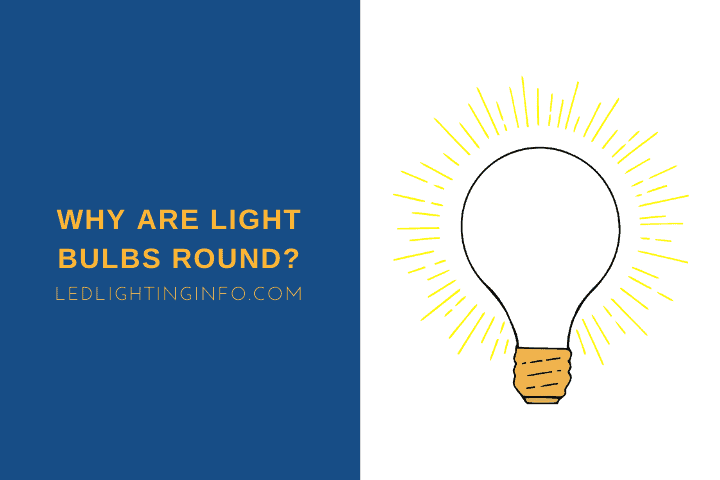If you’re a video game lover, you would know that when new, high definition games with superior graphics are released, players prefer that the games be ‘backward compatible.’
This means that the much more advanced games should still be playable on gamers’ existing older consoles that they have invested in.
Not everyone can afford to throw out their older machines for every new game release, even though the older console cannot utilize the full potential.
Similarly is the case in other technological advancements, and LED lighting is one of them.
Bulbs in a round shape were the easiest and most natural shape to manufacture, providing some technical advantages like the higher surface area to volume ratio and equidistant filament placement that allowed even light distribution.
Does Light Bulb Shape Affect Light Illumination?
Let’s find out if the shape of a light bulb affects the way the light is emitted.
In traditional bulbs, the light source needed to be equidistant from all sides of the glass casing to give out light that was uniform and omnidirectional to maximize efficiency.
A round bulb shape allows for the central light source, such as the tungsten filament, to follow those criteria.
On the other hand, a square bulb, for example, would not be entirely efficient in being uniform in all directions and give off light unevenly.
Other light bulbs on the market that are not a pear, spherical, or globe shape, are shaped for aesthetic or structural reasons.
For example, a common household filament bulb is the candle shaped bulb that is mainly decorative in purpose as it gives off warm light and can be placed in chandeliers and antique lamps.
What So Special About Spherical Shape?
You were given the task of coming up with a glass enclosure or casing to house a burning hot metal filament with electricity running through it.
I would like to bet you would create the famous A-type bulb. It is so fool-proof that the shape of this bulb has not changed since Edison produced the first commercially practical model in 1897.
The spherical/circular/pear-shaped bulb shape is the most efficient, least expensive, easiest to produce, and easiest to reproduce at scale shape out there.
Think about the traditional glass making process. Hot glass is shaped by blowing air into it, which naturally expands the glass into a round shape (think of blowing a balloon!)
It is rolled onto metal surfaces to tweak out flaws and make it completely round, allowing a further round shape to develop.
Of course, this was the process many decades ago, and since years the process of bulb making is automated.
The frames that hold the mold are round so that hot glass can be equally and quickly expanded into the circular frame, as opposed to other shapes like cubes and square edges.
The round frame leaves no corners unfilled or overfilled, creating creases, bulges, or uneven thickness. This allows for the most uniform dispersion of light to take place most cost-effectively.
You also need to consider one more reason. An incandescent is either completely empty or filled with gases. To fill the bulb with other gases or rid it of oxygen, the bulb needs to be vacuum pumped, so all the air is sucked out.
This vacuum pressure is pretty strong. So strong, in fact, that it can make a weak structure collapse onto itself.
Good thing then, that a spherical shape is one of the more durable forms with no bending stress, and is thus the chosen shape for a light bulb.
Otherwise, the sides of a bulb would simply cave in from the vacuum pressure if the bulb’s shape was not round.
As opposed to a square or triangular shape, a round bulb will have no structurally weak points. That makes it more reliable, and the bulb does not cave in. It’s the same principle that allows a dome roof to stay intact.
Another advantage of a circular shape is that it has the highest volume in relation to the surface area. This simply means that the least amount of material that is glass needs to be used to produce the shape with the largest volume.
But why does the bulb need to be voluminous?
There are two reasons for this:
As explained above, older traditional bulbs have the tungsten filament that gets white-hot when in operation.
The hot filament needs to be kept as far away from the fragile glass edges as possible to prevent heat loss to the surrounding and to prevent damage.
A large volume means that the glass can stay away from the hot filament, simultaneously not wasting too much glass material to allow that space.
The second reason for having a bulb with enough volume is that bulbs like halogen bulbs can be filled with enough gases to function well.
Can Light Bulbs Have Different Shapes?
But you might have come across many bulbs that are, in fact, not round at all!
Well, light bulbs can definitely have different shapes to suit different applications. In some cases, it is better to use a non-spherical bulb. In contrast, in other cases, it is merely a matter of aesthetic appearance.
It is a matter of lighting design and ingenuity to create unique lighting setups, including bulbs. Due to this, you will find designer LED bulbs that are cuboid or square in shape.
In fact, here is a figure of a variety of various bulb shapes commonly available in the market today.

Even when you consider CFL and fluorescent lamps, they are mostly tubes. When used in purpose-built fixtures, they are used as long straight tubes.
However, when they need to replace traditional bulbs, the tubes are wound into a twisted or spiral design in order to shape them more or less into a regular bulb shape.
LED vs Incandescent Bulbs: Does The Shape Matter?
When it comes to LEDs, the most efficient bulb shape is the most suitable shape for a luminaire and does not have to be the traditional round shape.
For instance, look up at your flush ceiling light. It houses a flat LED panel with the LED diodes spread evenly around.
Nevertheless, you will come across LED bulbs designed to look exactly like incandescents in their shape.
Again, the reason is simply to allow backward compatibility.
Since traditional bulbs were round and used screw-type bases, the majority of existing fixtures are shaped to house these round bulbs, and industry standards are established.
Making LEDs spherical allows them to be easily interchanged into fixtures already in use.
The reality is that LEDs need neither the high voltage from the main AC current nor the screw type bases and, least of all, the round bulb shape.
Final Words
So that is the long and short of various bulb shapes used in the industry today, and why mainly the form you will find most commonly is the round spherical shape.
What shapes of bulbs do you have around your home or office?
Can your fixtures house non-round shaped bulbs?
Looking for an LED bulb but not sure what type you need?
Check out my free bulb picker and select the right bulb within few clicks.



